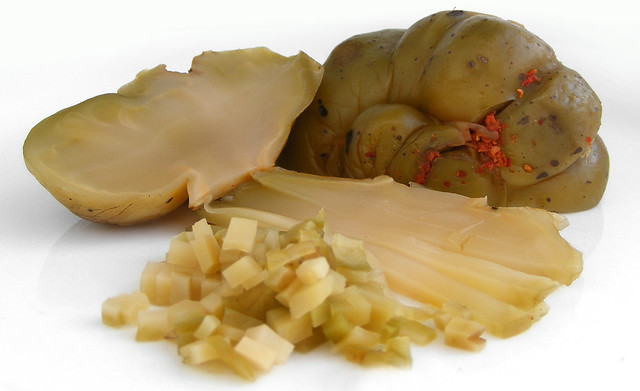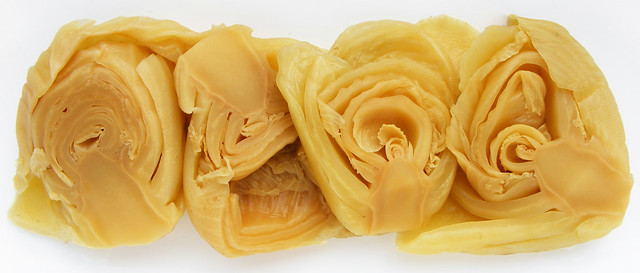Finding your way in Asian supermarkets isn’t always easy, with all its strange looking products and incomprehensible labels. With this site I want to offer a helping hand, provide information on products and ingredients, explain how to use them and refer to good recipes all over the web. Continue reading…..
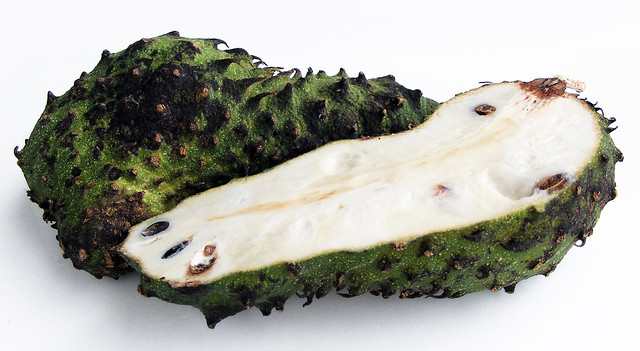
What’s it called?
Soursop, guanábana, graviola, soursapi, Brazilian pawpaw, prickly custard apple, Annona muricata (L). Mãng cầu Xiêm / mãng cầu ga (Vietnam), thurian-thet / thurian-khaek / rian-nam (Thailand), guyabano (Philipines), zuurzak (Netherlands), sirsak / nangka belanda / durian belanda (Indonesia), cì guǒ fān lì zhī / 刺果番荔枝 (China)
What is it?
A soursop looks like this stretched, curved , pear-shaped, green fruit with spikes from 10 cm up to 35 cm big. The inside has a white, pudding-like texture but is also a bit stringy and has big, brown, shiny seeds. Soursop tastes sweet and sour at the same time, like a combination of strawberry, banana and lime. It’s really, really nice.
How to use it?
Best to first peel the soursop, then cut it lengthwise and pull out the stringy core (like pears have). Over a bowl, push out the seeds one by one (see: illustrations). The result will look a bit like shiny, mushed banana. (photo). It’s much easier to buy prepared soursop, available frozen or canned. Blend the fruit for a few minutes and pass through a sieve to make sure there are no stringy bits left. Use in drinks, smoothies or icecream. It’s okay for fresh soursop to have some black spots, through the thick, leathery skin you should be able to feel the inside to be soft. Fresh soursop doesn’t keep very well, that’s why it’s not readily available in the West. The flesh turns brown when exposed to air.
Tips, tricks & recipes
- Make soursop juice by blending soursop with (a combination of) milk / coconutmilk / condensed milk / water / and bring to taste with palmsugar / suiker / lime / lemon / nutmeg / vanilla / cardemom / cinnamon or what you think is nice.
- Tea made of soursop leaves is believed to cure/prevent many illnesses.
- Because the dutch in Indonesia immediately fell in love with soursop (sirsak), but pretty much hated its relatives durian & jack fruit the Indonesian started calling the soursop “nangka belanda”or “durian belanda”. (meaning dutch nangka or dutch durian)
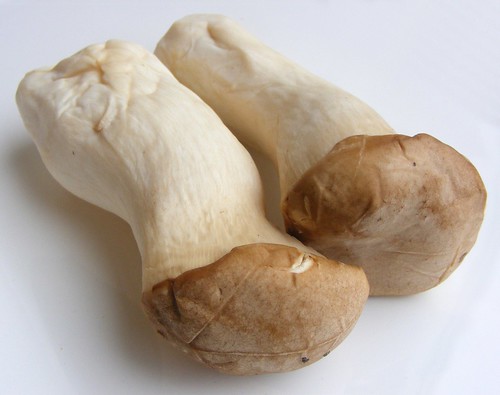 What’s it called?
What’s it called?
King oyster mushroom, king trumpet mushroom, king brown mushroom, french horn mushroom, boletus of the steppes, trumpet royale, Pleurotus eryngii (L). Cardoncello (Italy), koningsoesterzwam / kruisdistel oesterzwam / duinvoetje (Netherlands), eringi / エリンギ (Japan), saesongi peoseot / 새송이버섯, (Korea), xìng bào gū / 杏鮑菇 / cì qín gū / 刺芹菇 / cì qín cè ěr / 刺芹側耳 (China).
What is it?
This is the biggest mushroom in the family of Oyster Mushrooms. Originally from the around the Mediterranean, but nowadays you can find the king oyster mushroom all over Europe and Asia too. In fact, many are grown in and exported from Korea. The mushroom has a thick, round, meaty stem with a small, light brown cap.
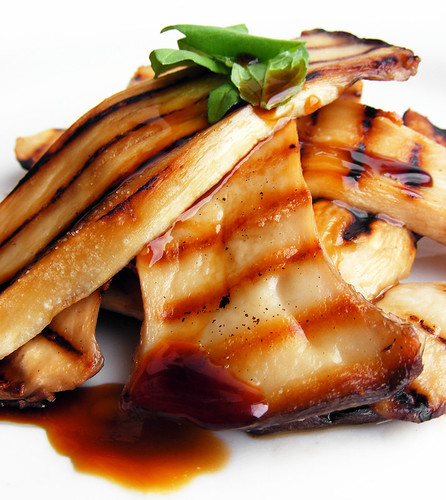 How to use it?
How to use it?
King oyster mushrooms don’t have much taste when eaten raw, but when panfried or grilled they have a lovely, meaty umami taste. King oyster mushrooms are one of the best tasting mushrooms, the texture is slightly reminiscent of abalone. Just grill or panfry in slices on high heat and simply add a little melted butter, garlic and soy sauce. You can keep king oyster mushrooms for quite some time, vacuum packed, in the fridge.
Tips, tricks & recipes
- Recipe: my Asian mushroom risotto
- Wikipedia: about king oyster mushroom
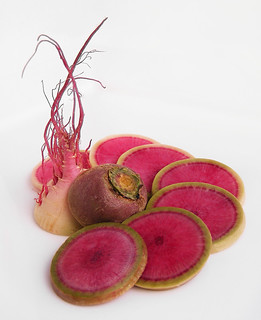 What’s it called?
What’s it called?
Watermelon radish, Japanese radish, Chinese radish, watermelon daikon, Asian red meat radish, beauty heart radish, roseheart radish, misato rose radish, Raphanus sativus L. ‘Red Meat’, shinrimei / xīnlǐ měi luóbo / 心里美 (China).
What is it?
This originally Chinese radish (strangly enough often called “Japanese radish”) is bigger than the radish we know in the West, sometimes much bigger. The literal translation of the Chinese name is “beautiful heart”, because while the outside looks like a boring white turnip (“dipped upside down” in green or purple) the inside is a sensationally fuchsia red and looks like a watermelon. The taste and texture of a watermelon radish is more like daikon than radish. Mildly peppery with a firm bite, but less watery than a radish. It tastes really nice!
How to use it?
Just cut the radish in slices, strips, cubes, discs, julienne, brunoise or when you have one of those gadget-machines in spaghetti like strips. You can braise or grill them, then the taste and colour will mellow down a bit. Also nice in salads, just raw. Perfect for pickling with a little rice vinegar, sugar and salt. You can use them in any recipe that calls for radish or daikon. Keep refridgerated.
Tips, tricks & recipes
- Recipes: winter radishes (e.g. roasted, fermented, in a risotto, etc)
- Not that difficult to grow yourself if you can find the seeds.
- Can be a cool substitute for the meat in steak tartare. Serve with capers, mayo, etc.
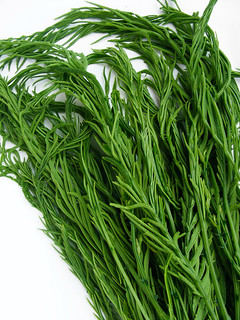 What’s it called?
What’s it called?
Acacia leaf, climbing wattle, stinky leaf, Acacia pennata / Senegalia pennata (L), cha-om / ชะอม (Thailand), su pout ywet (Birma), khang (India).
What is it?
Cha-om are the young leaves of the Acacia Pennata, a small member in the Acacia family, mainly known in Thailand, Burma, Laos and Indonesia. At first glance you might think it’s some sort of dill, but when looking closer you see the leaves look a bit like feathers or fern (photo). The woody stalks have nasty thorns (photo), you only eat the tender leaves.
How to use it?
Raw cha-om has a bit of a nasty, metallic smell, that’s why some people call it “stinky leaf”. You could eat it raw if you’d really want to but usually it’s cooked or stir-fried because that will eliminate the nasty smell completely. The taste will turn nutty, warm and fragrant. Wash the cha-om, then pick the leaves and disregard the stems. You can use the leaves in soups, curries and stirfries, but most commonly it’s used in omelet.
Tips, tricks & recipes
- Recipe: simple cha-om omelet
- More info: thaifoodandtravel.com.
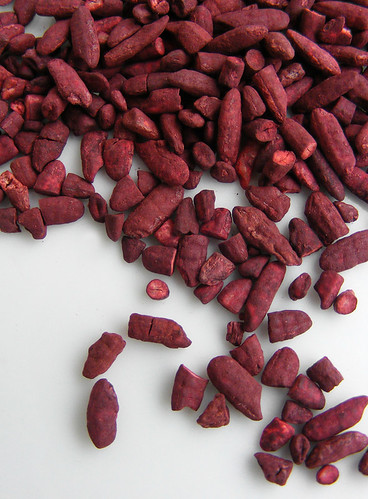 What’s it called?
What’s it called?
Red rice yeast / red yeast rice / red fermented rice / red rice koji / akakoji (EN), anka / ang-kak (Indonesia), hong-gug / 홍국 (Korea), hóng qú mǐ / hung kuk mai / 红曲米 (China)
What is it?
Red rice yeast is just normal, steamed, white rice which has been left to ferment for 4-6 dayes with the mold Monascus purpureus which colors the rice beautifully red.
How to use it?
Red rice yeast is often used as natural food coloring, e.g. in fermented tofu , red rice vinegar and sometimes also in Char Siu (red bbq pork), Peking duck and all kinds of red, Chinese pastry. Besides that it’s used to color some Chinese, Japanese and Korean rice wines pink. You can also just cook your red yeast rice like normal rice (1 cup rice : 1½-2 cups water, for 25 minutes) and eat it for supper, although I can’t recommoned that as it’s bitter and has a metallic taste to it. If kept airtight you can keep red rice yeast for several months.
Tips, tricks & recipes
- Also read the article about : Fuzhou red wine with step-by-step instructions to make this ricewine at home.
- Because some claim red rice yeast is very healthy you can buy concentrated red rice yeast in tablets at drugstores and pharmacist. It’s supposed to influence your cholesterol, bloodpressure and digestion.
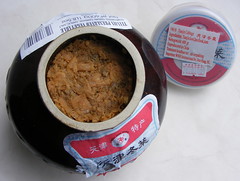 What’s it called?
What’s it called?
Tianjin preserved vegetable, Tianjin preserved cabbage, Tientsin preserved vegetable, Tianjin winter vegetable, Tiānjīn dōngcài / 天津冬菜 (China), tang chai (Thailand).
What is it?
Tianjin preserved vegetable is made with a thinner, more slender kind of napa cabbage from the Tianjin region called Tianjin cabbage / 天津白菜. The cabbages are first sundried, then chopped into thin strips, rubbed with salt and usually some garlic too and put in earthenware pots to ferment. It tastes a bit like sauerkraut only much more intense. And it tastes strongly of garlic too.
How to use it?
Chop finely and use a little bit of it in soups, stir fries and stews. It is rather salty so it’s a good idea to rinse it first. Tianjin preserved vegetable is normally used in small quantities. To prevent your dish getting too salty, wait with seasoning it with salt or soy sauce until after you’ve added the Tianjin preserved vegetables. Often sold in typical, brown earthenware jars like in the photo above that you can keep in your cupboard almost indefinitely.
Tips, Tricks & Recipes
- Recipe: dry fried green beans
- Click to compare with other: Pickled Vegetables (like zha cai, ya cai and suan cia)
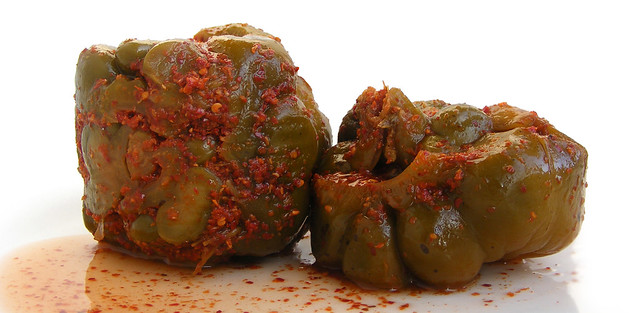
What’s it called
Sichuan preserved vegetable, Szechwan vegetable, Chinese pickled vegetable, pickled mustard tuber, zha cai / zhàcài / 榨菜 (China). Also: tsa tsai / jar choy / jar choi / ja choi / ja choy / cha tsoi.
What is it?
The pickled, rather strange looking stem of a special kind of mustard cabbage from Sichuan, the Brassica juncea var. tsatsai (see photo). These fist-sized bulby stems are rubbed with plenty of salt, then pressed with weights to slowly release its moisture. Then they are dried, rubbed with red, hot chili paste and left to ferment in big earthenware jars. This process is pretty similar to the way Koreans make kimchi and the taste and texture is a bit like our pickled cucumber.
How to use it?
You usually find Zha Cai in tins. Open the tin, then cut off the piece you need, rinse off the chili paste, de-salt it by soaking it for about half an hour in a cup of water, vinegar or white wine. Then cut it into small strips or cubes and use in all kind of dishes. You can braise, cook, stir-fry or even eat it raw, as a pickle. Zha cai bought in bags usually is already cut into strips for you. Never keep leftovers in the tin, transfer to a small container or plastic bag and keep refrigerated. It will keep for months if not years.
Tips, Tricks & Recipes
- Recipe: Szechuan Pickled Vegetables with Shredded Pork
Recipe: Savoury Tofu Pudding - Click to compare to other Chinese preserved vegetables (yacai, tianjin dongcai, etc)
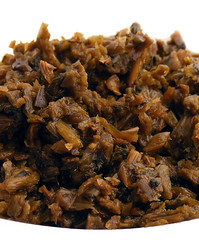 What´s it called?
What´s it called?
Ya cai / 芽菜, suimi ya cai, preserved mustard greens from Sichuan, Sichuan pickled mustard cabbage.
What is it?
The pickled leaves of a mustard plant variety “guang gan qing cai”, only known/grown in Sichuan. The leaves, which are first rubbed with salt and sundried are layered in stoneware pots, together with sugar and maybe some chilli pepper and left to ferment for months. Ya cai is one of the basic tastes of Sichuan cuisine.
How to use it?
Ya cai is very difficult to find in the West, the most famous brand (Suimi) is sold in little, convenient bags . It’s probably best to rinse it under the tap to get rid of the excess salt. Then squeeze it to get rid of the water. You can shortly stir fry it in some oil to make it semi-crunchy and use as a garnish. You can also add it to the garlic and ginger when making a stir fry.
Tips, Tricks & Recipes
- Ya cai is used in some of the most famous Sichuan dishes like Dan Dan Noodles or stirfried green beans.
- Click to compare with other: Asian pickles
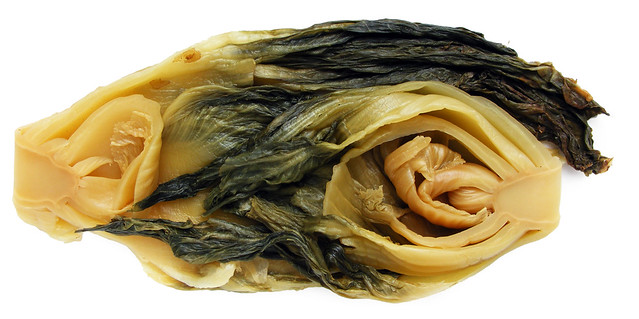
What’s it called?
Chinese sauerkraut, Chinese kimchi, pickled Mustard Greens, dưa chua (Vietnam), swan tsai / suān cài / 酸菜 (literally: sour vegetablesn) or xián cài / 鹹菜 (literally: salted vegetables) (China).
What is it?
Suan cai probably is the very first version of sauerkraut; cabbage is shortly blanched in boiling water, then sundried, sprinkled with plenty of salt, transferred to big earthenware jars and topped with weights that will slowly press out all moisture during fermentation. In the North of China they use napa cabbage (sometimes even plain, white cabbage, like in sauerkraut), in the South of China they use the less familiar jie cai (Chinese mustard cabbage). Similar to sauerkraut, suan cai tastes sour, not salty as you might expect.
How to use it?
Often sold in plastic bags. Rinse the suan cai under the tap, then leave it for a while in some water (with a dash of vinegar) to get rid of most of the excess salt. Use some chopped suan cai as topping on beef noodle soup, to flavor the filling of jiaozi, incorporate it in stir fries or simply serve it as a little side dish. It’s the suan cai that gives the typically sour edge to the broth for Northern Chinese style hotpot. Suan cai goes well with greasy pork or fish. Sealed in its bag you can keep it for months, if not years. Once opened you can still keep it quite some time, but best refrigerated.
Tips, Tricks & Recipes
- Easy recipe: making your own suan cai (with just cabbage and salt)
- Vegetarian recipe: tofu stir-fry with suan cai.
- Don’t confuse with zha cai or ya cai, also “pickled mustard cabbage “, but from a different variety and from Sichuan. Or Tianjin dong cai, pickled napa cabbage from Tianjin.

